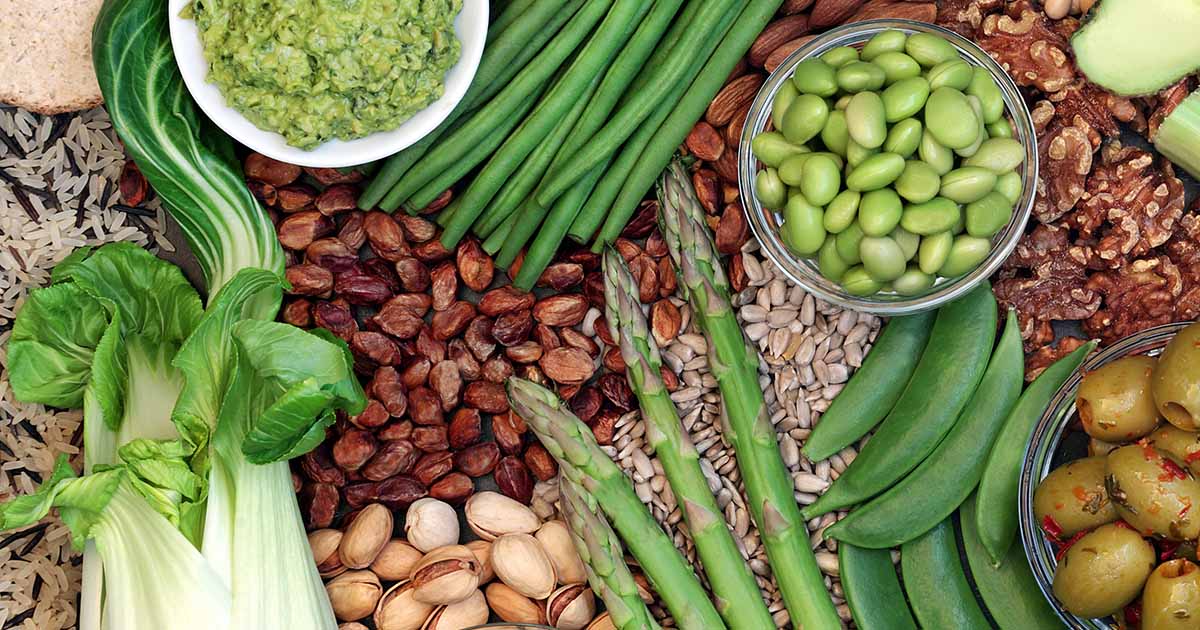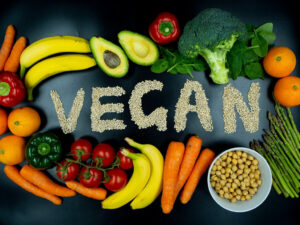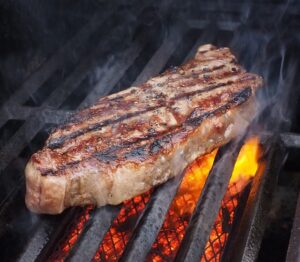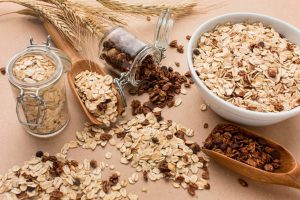Humans have been eating plant foods for as long as we have roamed the Earth. It is estimated that throughout their time on Earth, humans have used around 3,000 plant species and cultivated about 150 plant species for their personal use (11). The major groups of plant foods that supply the most protein are legumes and cereal grains. Around the world, plant proteins make up about 65% of all protein eaten (11).
People in the United States consume a high percentage of animal protein (70% of their protein intake), while countries to the east consume much less animal protein (20% of their protein intake) (11). Some parts of Asia rely heavily on fermented soy for their protein intake. Countries that do not raise livestock also rely on plants for their protein. The United States has some of the highest intakes of animal protein per person worldwide. This may be the reason that people in the US think that we must consume animals to meet our protein needs. Fortunately for vegans, it is very possible to meet protein needs without consuming any animal products!
A lot of the information in this blog comes from a blog I wrote a few months ago all about protein, how much we need, how we come up with protein requirements, and protein requirements for athletes. That blog is called America’s Protein Obsession: How Much Do We Really Need? If you want a more thorough background on protein, I suggest reading that blog, as I will not go into detail on this blog. Let’s start with the building blocks of protein, amino acids.
Relationship of amino acids to proteins
Proteins are made up of amino acids. There are 20 amino acids in total. Our body can make some of these, called dispensable amino acids, while others we must get from our diet, called indispensable amino acids. When you hear someone say that animal protein is more complete than plant protein, they are talking about the amino acid composition of the food. A complete protein means that it contains all nine of the indispensable amino acids, while an incomplete protein does not contain all nine indispensable amino acids. Soy is the only plant considered a complete protein source. While our body is capable of making dispensable amino acids, we must still supply it with nitrogen, which the body then uses to make the amino acids.
Complete is not necessarily better
Being a complete protein source does not mean that a food is better for you than an incomplete protein food. Animal proteins contain more nitrogen than plant-based proteins. Nitrogen is a byproduct of protein breakdown and must be eliminated by the body. This means the body must work harder to break down and remove the extra nitrogen from meat. It is debatable whether or not this process leads to reduced kidney function (since kidneys excrete the nitrogen). I do not believe that excess animal protein or nitrogen will damage the kidneys unless you already have kidney damage. The major problem with this is that someone may be in the early stages of kidney disease without knowing it, so for these people, excess animal protein would be damaging.
If you eat a variety of plant foods, whether or not each individual food is a complete protein is irrelevant. Each different plant food contains different types and amounts of amino acids, so they end up making a complete protein anyway. It is not necessary to consume only complete proteins.
Protein complementation
There was a widespread belief in nutrition not too long ago that different plant sources of protein had to be eaten together based upon their different amino acid makeup. This is referred to as protein complementation. The idea behind this is that by eating one food source lacking some amino acids with another food source that has that amino acid, together they form a complete protein. An example would be eating rice and beans together at the same meal since they each complement the lacking amino acids of each other and form a complete protein. It was initially believed that these foods would have to be eaten together or within a few hours of each other.
Since that time, science has disproved this idea. It was found that each individual amino acid does not have to be consumed each day, but the average intake over a few days is what matters (1). This idea of plant foods having to be eaten together was taught up until last year in my nutrition classes, so I can only assume there are still many people who believe this and use it as an argument to show the inadequateness of plant-based protein.
How well plant protein is digested and the availability of amino acids
Typically, animal protein is better digested than plant protein. The factors that lower the digestibility of plant foods include tough cell walls (millet), anti-nutritional factors (beans), or processing and heat treatment (breakfast cereal) (2). Knowing this, we can take steps to increase the digestibility of plant foods.
Protein digestibility is greatly enhanced with boiling. Protein digestibility of uncooked legumes (I have yet to meet someone who eats uncooked legumes) is around 34–37% (3). This means that if a serving of legumes has 30 grams of protein, 34%, or 10 grams, will be digested. Boiling legumes increases the protein digestibility to 63–72%, an increase of about 90%!
A study found that boiling chickpeas does not reduce the total protein in this food (4). Boiling did not significantly affect the amino acid composition of the chickpeas. In vitro protein digestibility was enhanced with boiling.
Anti nutrients in plants
Put simply, anti-nutrients interfere with the absorption of some nutrients. The anti-nutrients in plants may reduce protein digestibility. Here is a summary of the anti-nutrients in some plant foods like beans: tannins, phytic acid, protease inhibitors, and lectins (5). All of these anti-nutrients can affect our ability to absorb and digest plant proteins.
It was found that soaking peas for 24 hours significantly reduced levels of phytic acid (5). A study soaked legume seeds (chickpeas, flava beans, and kidney beans) for 16 hours and then measured levels of tannins and phytic acid (6). After soaking, there were significant reductions in phytic acid in all the legumes tested. There were also significant reductions in tannins and total phenols in all legumes tested. Protein digestibility was enhanced by soaking. Another study found that both boiling and microwaving greatly reduced the tannin and phytic acid content of legume seeds (7).
Dietary protein intake of vegans vs. non vegetarians
A study comparing the four-day dietary intake of vegans and non-vegetarians found similar intakes of protein between both groups (85 grams/day for non-vegetarians and 75 grams/day for vegans) (8). Surprisingly, the vegan group had higher serum albumin levels than the non-vegetarian groups. Serum albumin is a measure of bodily protein stores; although not a very sensitive measure, it at least shows that vegans are likely not deficient in protein. An observed health benefit was that vegans had lower blood urea nitrogen levels than non-vegetarians. Urea is a waste product of the breakdown of protein, so lower levels are ideal.
Another study conducted in Sweden compared the diets of vegans to those of omnivores. It was found that vegans had significantly lower intakes of protein, although adequate, compared to omnivores (9). The vegan intake of protein fell on the lower end of sufficient protein intake, while the intake of omnivores fell on the higher end, with some individuals consuming more protein than is necessary.
A huge study with 38,000 participants found that vegans consume similar amounts of protein compared to meat eaters and vegetarians (10). When expressed as the percent of total calories, protein made up 16% of total calories for meat eaters, 13% for vegetarians, and 13% for vegans.
How much protein do we need?
The RDA sets a protein intake for everyone over 19 years of age at 0.8 g protein per kg of body weight. This would be 72 grams of protein per day for a 200-pound man. This is assuming he is not physically active. Looking at all of the data, I would say that an adequate protein intake for physically active people would be 1.33 grams of protein per kg of body weight each day. Beginning bodybuilders who are actively putting on muscle mass may require more than 1.33 grams of protein per kg of body weight. I tend to side with the researchers that say once we have achieved our optimal muscle mass, protein needs leveling out as we are supporting the muscle mass and not actively building new cells, at least not at the rate of beginning lifters.
To convert your body weight to kg, just divide your weight in pounds by 2.2. This will give you your weight in kg. From there, multiply this number by 0.8 if you are sedentary or 1.33 if you are active or lift weights. This number will give you the total amount of protein in grams you need per day. If you weigh 180 pounds (180/2.2), that comes out to 82 kg. If you multiply 82 by 0.8, you get 66 grams of protein per day. If you multiply 82 by 1.33, you get 110 grams of protein per day. Neither amount is difficult to reach with a vegan diet.
Protein chart for plant foods
| FOOD | AMOUNT | PROTEIN |
| (gm) | ||
| Tempeh | 1 cup | 31 |
| Soybeans, cooked | 1 cup | 29 |
| Lentils, cooked | 1 cup | 18 |
| Black beans, cooked | 1 cup | 15 |
| Kidney beans, cooked | 1 cup | 15 |
| Pinto beans, cooked | 1 cup | 15 |
| Veggie burger | 1 patty | 13 |
| Tofu, regular | 4 ounces | 10 |
| Bagel | 1 med. (3.5 oz) | 10 |
| Quinoa, cooked | 1 cup | 8 |
| Spaghetti, cooked | 1 cup | 8 |
| Almonds | 1/4 cup | 8 |
| Soy milk, commercial, plain | 1 cup | 7 |
| Whole wheat bread | 2 slices | 7 |
| Spinach, cooked | 1 cup | 5 |
| Broccoli, cooked | 1 cup | 4 |
Discussion
As you can see from the above chart, reaching daily protein requirements with a vegan diet is not difficult, as long as you eat a variety of beans, seeds, whole grains, and tofu. While vegans may have slightly less protein intake than meat eaters, their intake is still sufficient to meet all of our protein needs. Anyway, there are no known benefits to eating excessive protein. Despite popular belief, you can be a bodybuilder while following a completely vegan diet. There are actually quite a few vegan bodybuilders. Here is a page with a ton of http://www.greatveganathletes.com/bodybuilders.
If you still have trouble meeting protein needs with a vegan diet, you can always supplement your diet with vegan protein shakes. I discussed the pros and cons of different vegan protein shakes in my blog, Nutritional Concerns of a Vegan Diet. For my next blog, I will discuss whether or not boiling or microwaving vegetables destroys the vitamin content. Thanks for reading!
Sources
- Young, V. R., & Pellett, P. L. (1994). Plant proteins in relation to human protein and amino acid nutrition. The American journal of clinical nutrition, 59(5), 1203S-1212S.
- Millward, D. J. (1999). The nutritional value of plant-based diets in relation to human amino acid and protein requirements. Proceedings of the Nutrition Society, 58(02), 249-260.
- Rehman, Z. U., & Shah, W. H. (2005). Thermal heat processing effects on antinutrients, protein and starch digestibility of food legumes. Food Chemistry, 91(2), 327-331.
- El-Adawy, T. A. (2002). Nutritional composition and antinutritional factors of chickpeas (Cicer arietinum L.) undergoing different cooking methods and germination. Plant Foods for Human Nutrition, 57(1), 83-97.
- Alonso, R., Orue, E., & Marzo, F. (1998). Effects of extrusion and conventional processing methods on protein and antinutritional factor contents in pea seeds. Food Chemistry, 63(4), 505-512.
- El-Hady, E. A., & Habiba, R. A. (2003). Effect of soaking and extrusion conditions on antinutrients and protein digestibility of legume seeds. LWT-Food Science and Technology, 36(3), 285-293.
- Khattab, R. Y., & Arntfield, S. D. (2009). Nutritional quality of legume seeds as affected by some physical treatments 2. Antinutritional factors. LWT-Food Science and Technology, 42(6), 1113-1118.
- Haddad, E. H., Berk, L. S., Kettering, J. D., Hubbard, R. W., & Peters, W. R. (1999). Dietary intake and biochemical, hematologic, and immune status of vegans compared with nonvegetarians. The American journal of clinical nutrition, 70(3), 586s-593s.
- Larsson, C. L., & Johansson, G. K. (2002). Dietary intake and nutritional status of young vegans and omnivores in Sweden. The American journal of clinical nutrition, 76(1), 100-106.
- Spencer, E. A., Appleby, P. N., Davey, G. K., & Key, T. J. (2003). Diet and body mass index in 38 000 EPIC-Oxford meat-eaters, fish-eaters, vegetarians and vegans. International journal of obesity, 27(6), 728-734.
- Young, V. R., & Pellett, P. L. (1994). Plant proteins in relation to human protein and amino acid nutrition. The American journal of clinical nutrition, 59(5), 1203S-1212S.





Interesting…… I found here a vegan restaurant, when you come next time I’ll take you there. It’s a hard transition, but for health issues we need to change a lot . Regards !
Hey Bernal. Sounds good! Have you been there before?
I used to eat meat every single meal. I felt my meal was not complete if I did not have a piece of beef, chicken, seafood… Lately I can have a vegan/vegetarian dish and be satisfied. 🙂 Even though I think Vegans can be healthier I do like my meat very much. 😉
I enjoyed reading the chart and like you mentioned, it is not difficult for a vegan to reach the daily protein levels if you plan and know what to eat. Good blog!